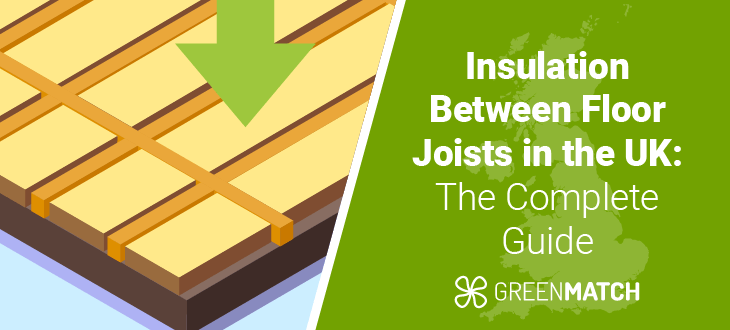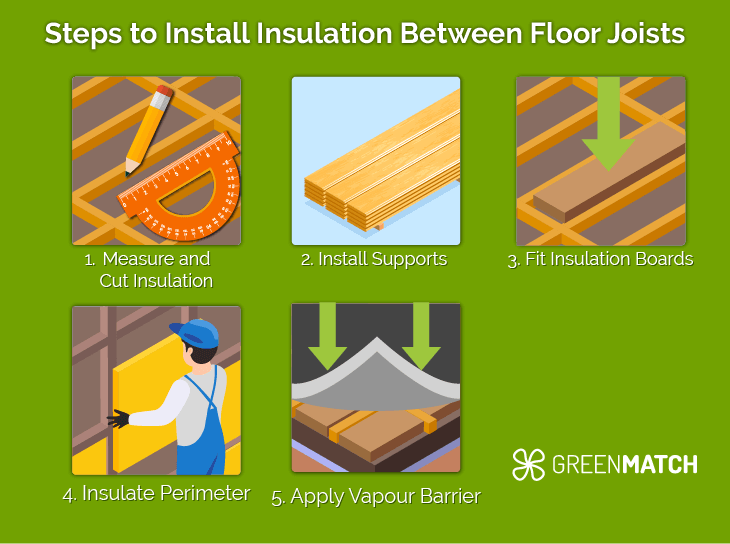Answer these simple questions and we will find you the BEST prices
Which type of solar quotes do you need?
It only takes 30 seconds
100% free with no obligation

Get Free quotes from insulation specialists near you

Save money by comparing quotes and choosing the most competitive offer

The service is 100% free and with no obligation
Insulation Between Floor Joists in the UK: The Complete Guide


- Insulation between floor joists works by adding a layer of insulation material between the joists to improve thermal efficiency and reduce noise transmission.
- The biggest benefit of insulation between floor joists in the UK is the improvement in energy efficiency and subsequent reduction in energy bills, which can be up to £100 per year for an average detached house.
- Insulating between floor joists typically costs £4,700, including installation. The cost will ultimately depend on the insulation material used and the amount needed.
Floor insulation between joists improves a home's energy efficiency by installing insulating materials in the spaces between floor joists, typically on suspended timber floors. This technique is particularly beneficial for homeowners with older properties, those living in colder climates, or anyone looking to reduce energy costs and improve indoor comfort. Creating a thermal barrier helps prevent heat loss through the floor, making living spaces warmer and more energy-efficient.
In this article, we'll explore the ins and outs of floor joist insulation, covering everything from what it is and how to install it to its pros and cons and associated costs. We'll also discuss relevant building regulations and help you determine if this insulation method is right for your home. If, after reading our guide, you’re still unsure about what this all means for you, you should consult a specialist who can offer tailored advice.
Fortunately, with our service, finding a reliable professional and comparing quotes couldn’t be easier. Just fill in our short form, and we’ll connect you with up to 3 local insulation experts. Spare yourself the hassle of endless googling, and click below to get started—it’s quick, simple, and completely free!
- Describe your needs
- Get free quotes
- Choose the best offer
It only takes 30 seconds



What is floor joist insulation?
Insulating between floors, or floor joist insulation, involves placing insulation between or beneath floor joists to improve a home's energy efficiency and comfort. However, why choose insulation between floor joists?
This method is particularly effective for suspended timber floors, common in older UK homes. Insulation can be installed by lifting floorboards and fitting materials like mineral wool or rigid foam boards between joists. Popular insulation materials include mineral wool, polyester rolls, and rigid foam boards, each offering different advantages in terms of thermal performance, fire safety, and ease of installation.
How to install insulation between floor joists?
As mentioned, the best floor insulation can greatly improve aspects of old retrofit UK homes. Here's a step-by-step guide to help you with insulation between floor joists:

By following these steps, you can ensure proper and efficient insulation installation between floor joists, enhancing your space's thermal performance. However, we cannot emphasise enough how important it is to contact an insulation expert for a professionally done installation.
Using our service, you can save time and effort by contacting multiple installers and contacting them hassle-free. Moreover, we can connect you with up to 3 installers from our trusted network. Click the button below to get started. You’re not obligated to accept any of their quotes; our service is completely cost-free.
- Describe your needs
- Get free quotes
- Choose the best offer
It only takes 30 seconds



Insulation between floor joists pros and cons

Pros of insulation between floor joists
- Improved energy efficiency by reducing heat transfer between floors.
- Increased comfort with warmer floors in winter and cooler floors in summer.
- Better sound insulation and reduced noise transfer between floors.
- Moisture control and prevention of condensation.
- Space-saving compared to other insulation types, as it's hidden between joists.
- Potential annual energy bill savings of up to £100 for the average detached house.
- Preservation of floor structure: It maintains airflow below insulated suspended timber floors, keeping the timber dry and preventing decay.
Cons of insulation between floor joists
- Adequate ventilation in the sub-floor void is crucial to prevent timber decay. Insulation must be installed without blocking ventilation paths.
- The process often involves removing floorboards, which can be disruptive and may cause damage if not done carefully.
- Insulation can lead to condensation issues without proper moisture barriers, potentially causing mould growth and timber decay.
- Ensure the Vapour Control Layer (VCL) is compatible with the insulation material to avoid interstitial condensation.
- Improper insulation can leave exposed floor joists as thermal bridges, leading to localised heat loss and increased risk of condensation and mould growth on the joists.
Assessing your specific home structure and needs is important when considering insulation between floor joists. While it offers significant energy efficiency and comfort benefits, proper installation and moisture management are crucial to avoid potential drawbacks.
Cost of insulating between floor joists
The cost of floor joist insulation in the UK is approximately £4,700, including installation. Homeowners can save up to £100 annually for detached houses and up to £60 for semi-detached homes, reducing 190 kgCO2 emissions per year.
The Great British Insulation Scheme (GBIS) and the Energy Company Obligation (ECO4) are the primary sources of grants for floor insulation in the UK. These government initiatives aim to improve home energy efficiency by funding various insulation measures, including underfloor insulation.
Some key points about GBIS include:
- Eligibility is based on the home's Energy Performance Certificate (EPC) rating (D to G) and specific Council Tax bands.
- The scheme covers up to 75% of insulation costs for eligible households.
- GBIS differs from the ECO4 scheme by allowing only one insulation measure per property.
- There are two categories: 'general' and 'low-income' groups.
On the other hand, the ECO4 scheme:
- The ECO4 scheme focuses on households with an Energy Performance Certificate (EPC) rating of D or lower.
- Offers grants ranging from £7,000 to over £20,000 per household, with a total funding pool of £4 billion.
- Eligibility is based on income and vulnerability, with a flexible component allowing local authorities to refer additional households in need.
- Places the responsibility on medium to large energy suppliers to assist low-income and fuel-poor households.
The GBIS is a UK government initiative that provides a single, targeted insulation upgrade per household to maximise its reach across the country. After a property assessment, the most effective measure to improve energy efficiency is selected, such as floor acoustic insulation.
The ECO4 scheme adopts a comprehensive approach by offering a variety of energy efficiency upgrades for the entire home. This includes insulation and enhancements such as heating system improvements and smart controls, ensuring a more holistic upgrade to residential energy performance.
This approach aligns with the UK government's goal of achieving net-zero carbon emissions by 2050 by making homes more energy-efficient and reducing heating costs nationwide.
Insulation between floor joists: Building regulations
Complying with local building regulations is essential when insulating floors. In England and Wales, the regulations require floors to achieve a U-value of 0.25 W/m2K or lower, where possible. This typically involves installing at least 70mm of high-performance foam insulation or 150mm of mineral wool, though requirements may vary based on factors such as floor type or size.
It’s important to note that if replacing more than half of a floor, you must insulate to these standards regardless of your original intentions. While installers often handle regulatory compliance, the property owner is ultimately responsible.
If you need specific information about regulations in your region or clarifications, it's advisable to contact your local Building Control Office or Building Standards Department before commencing any work. This ensures your project meets all necessary standards and avoids potential issues down the line.
Is insulation for floor joists the right choice for my home?
Insulation between floor joists is one of the most affordable insulation options in the UK, alongside cavity wall and loft insulation. It provides numerous benefits, such as improved energy efficiency, reduced energy bills, better sound insulation, and moisture control.
It is particularly suitable for retrofitted houses due to its space-saving nature and minimal structural disruption. Homeowners can save up to £100 annually on energy bills, and the insulation helps preserve floor structure by maintaining airflow and preventing timber decay.
Furthermore, grants like the Great British Insulation Scheme can assist homeowners in covering up to 75% of the insulation costs, making this option even more appealing. Has this sparked your interest in floor joist insulation? Fear not, as we can help you get the best deal!
Don’t waste hours contacting installers on your own. Simply fill out our 30-second form, and we’ll do the rest. We’ll connect you with up to 3 of our trusted installers near you for free, no-obligation quotes. Click below to get started!
- Describe your needs
- Get free quotes
- Choose the best offer
It only takes 30 seconds



FAQ
Insulating between floor joists is an effective solution, particularly for older homes. It significantly enhances energy efficiency, comfort, and noise reduction while minimising structural disruption during installation.
Common insulation materials include mineral wool, polyester rolls, and rigid foam boards.
To fit insulation between floor joists, lift the floorboards, place the insulation material snugly between the joists, ensure proper ventilation, and then replace the floorboards. However, for proper compliance, we recommend contacting an insulation expert.
To meet building regulations, the recommended thickness for insulation between joists is typically at least 70 mm for high-performance foam or 150 mm for mineral wool.

Alejandro is a copywriter at GreenMatch and is passionate about European environmental policy and renewable energy. He has conducted research on the European Green Deal’s impact on EU energy policy and climate adaptation, and he is committed to using his writing skills to promote sustainable policies.
We strive to connect our customers with the right product and supplier. Would you like to be part of GreenMatch?

- Insulation Between Floor Joists in the UK: The Complete Guide
- What is floor joist insulation?
- How to install insulation between floor joists
- Insulation between floor joists pros and cons
- Cost of insulating between floor joists
- Insulation between floor joists: Building regulations
- Is insulation for floor joists the right choice for my home?
- FAQ
